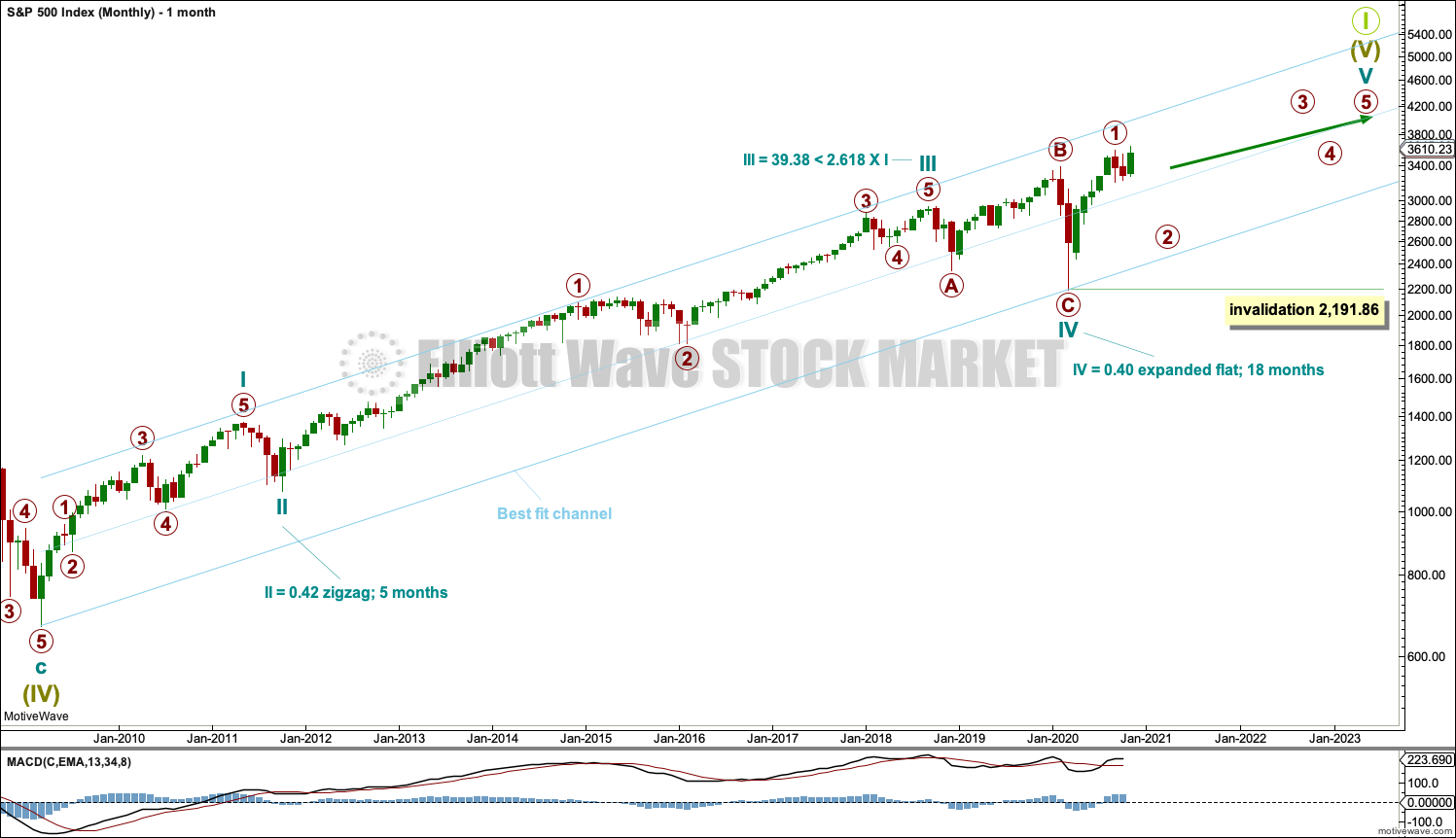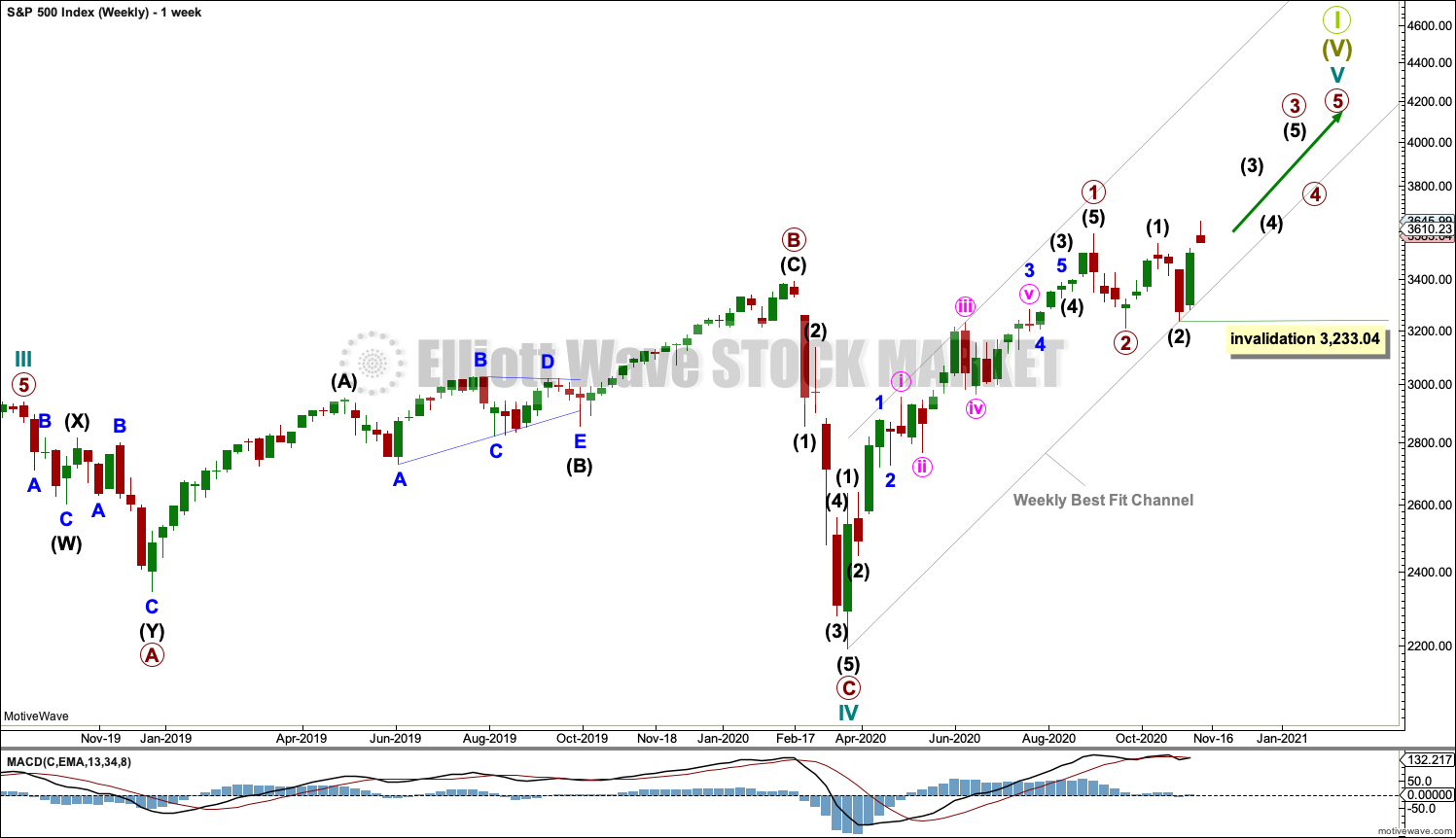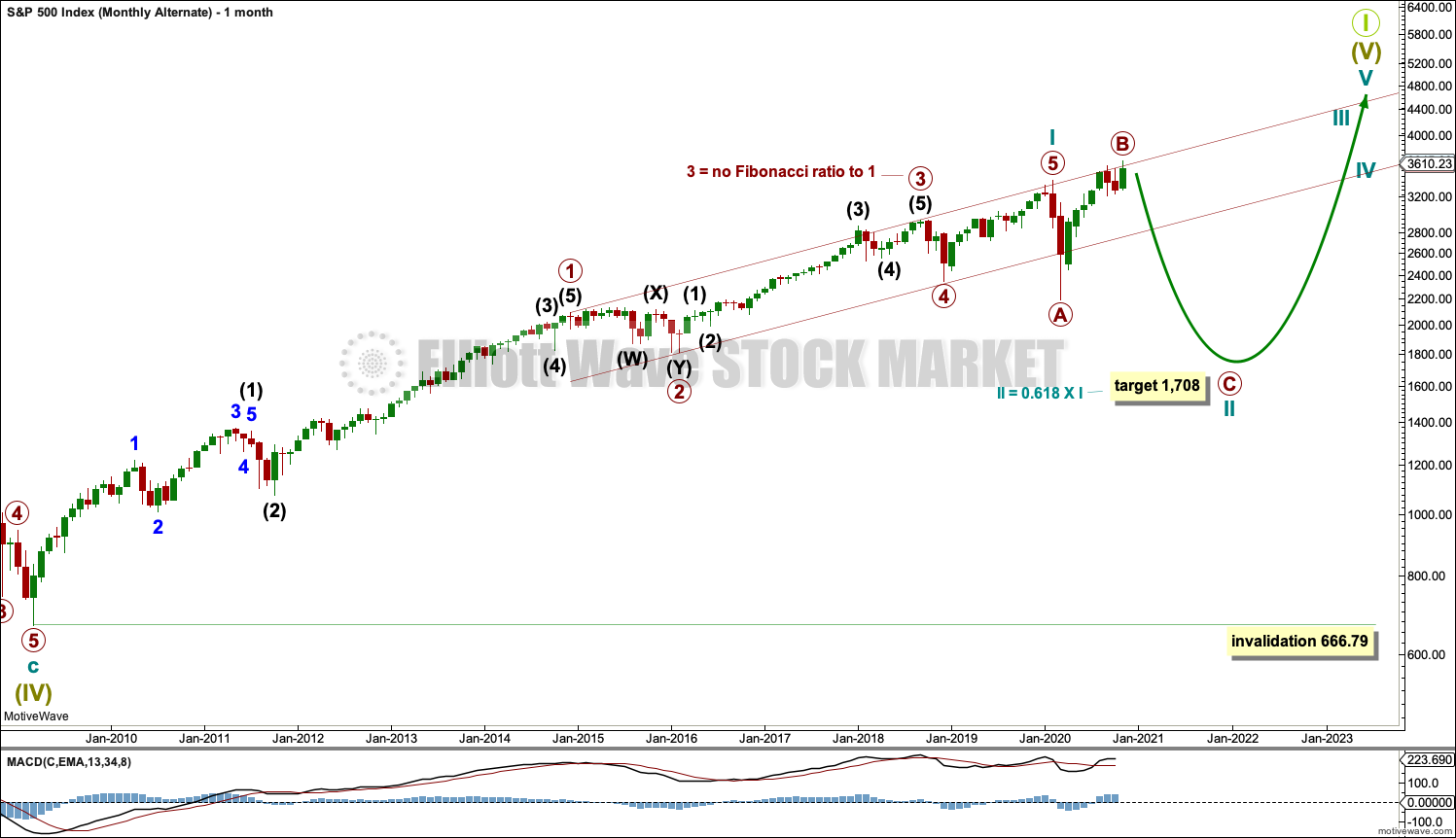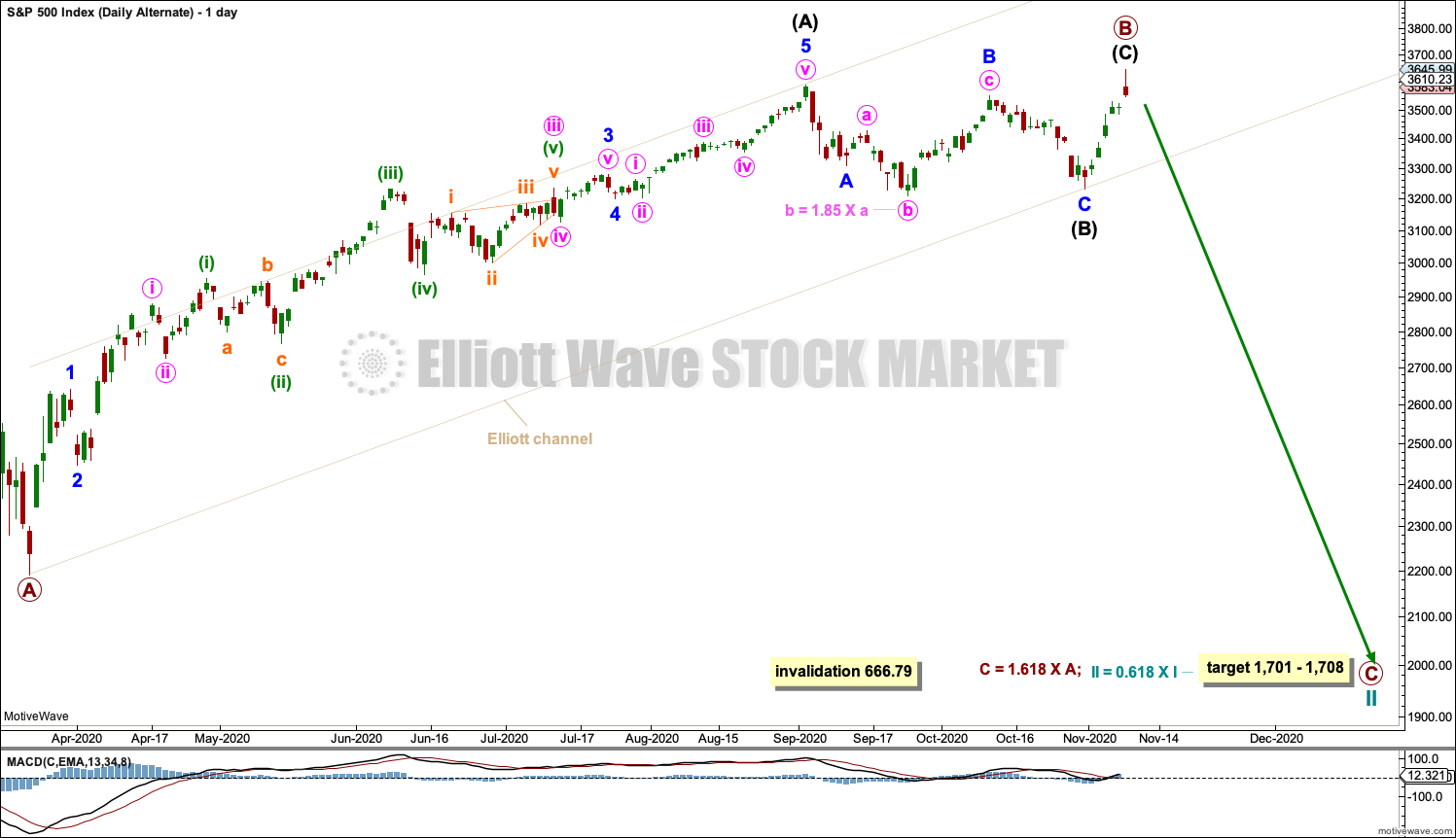Lara’s Weekly: Elliott Wave and Technical Analysis of S&P500 | Charts – November 9, 2020

S&P 500
The main Elliott wave count expected upwards movement, which is exactly what has happened. The alternate Elliott wave count is invalidated.
It is time to update monthly charts. Two Elliott wave counts are considered for the bigger picture.
Summary: The main wave count expects a low is now in. The target is at 4,606 and an invalidation point at 3,209.45.
If the main wave count is invalidated with a new low below 3,233.04 and then 2,191.86, then a new alternate may be used (previously only published in monthly chart analysis, now to be used daily). This wave count is very bearish. It expects a strong wave down to a target at 1,708. The invalidation point is 666.76.
The biggest picture, Grand Super Cycle analysis, is here.
ELLIOTT WAVE COUNTS
MAIN WAVE COUNT
MONTHLY CHART
The channel is a best fit.
There is alternation between a zigzag of cycle wave II and a flat correction of cycle wave IV.
Cycle wave V must subdivide as a five wave motive structure, most likely an impulse. Primary waves 1 and 2 within cycle wave V may be complete.
This wave count may allow time for the AD line to diverge from price as price makes final highs before the end of the bull market. The AD line most commonly diverges a minimum of 4 months prior to the end of a bull market.
Cycle wave V may last from one to several years.
WEEKLY CHART
Cycle wave V may last from one to several years. So far it is in its eighth month.
Cycle wave V would most likely subdivide as an impulse. But if overlapping develops, then an ending diagonal should be considered. This chart considers the more common impulse.
Primary waves 1 and 2 may be complete.
Primary wave 3 may only subdivide as an impulse.
There is already a Fibonacci ratio between cycle waves I and III within Super Cycle wave (V). The S&P500 often exhibits a Fibonacci ratio between two of its actionary waves but rarely between all three; it is less likely that cycle wave V would exhibit a Fibonacci ratio. The target for Super Cycle wave (V) to end would best be calculated at primary degree, but that cannot be done until all of primary waves 1, 2, 3 and 4 are complete.
DAILY CHART
Primary waves 1 and 2 may both be complete. Primary wave 3 may now be underway.
Primary wave 3 may only subdivide as an impulse. Within primary wave 3: Intermediate waves (1) and (2) may both be complete, and intermediate wave (3) may now be underway and may only subdivide as an impulse.
No second wave correction within intermediate wave (3) may move beyond the start of its first wave below 3,233.94.
Primary wave 1 looks extended. The target for primary wave 3 expects it to also be extended.
ALTERNATE WAVE COUNT
MONTHLY CHART
In last published monthly chart analysis this wave count was labelled the “third alternate”.
The channel drawn about cycle wave I is drawn using Elliott’s first technique. This channel looks text book perfect. The channel is strongly breached (at the weekly and daily chart level) indicating an end to the bull market, which began in 2009, and indicating a new bear market to follow.
Cycle wave II may not move beyond the start of cycle wave I below 666.79.
Cycle wave II may last about one to seven years in total.
If cycle wave I is a very long extension, then cycle waves III and V may not be extended.
WEEKLY CHART
Cycle wave II may be subdividing as an expanded flat. Primary wave B within the expanded flat is a 1.21 length of primary wave A, which is within the most common range for B waves within flats of up to 1.38. Expanded flats are reasonably common structures.
A 7 point target zone is calculated at two wave degrees.
Cycle wave II may not move beyond the start of cycle wave I below 666.79.
DAILY CHART
Primary wave B may be complete as a zigzag at today’s high. Primary wave C may now begin and must subdivide as a five wave motive structure, most likely an impulse.
Cycle wave II may not move beyond the start of cycle wave I below 666.79.
TECHNICAL ANALYSIS
WEEKLY CHART
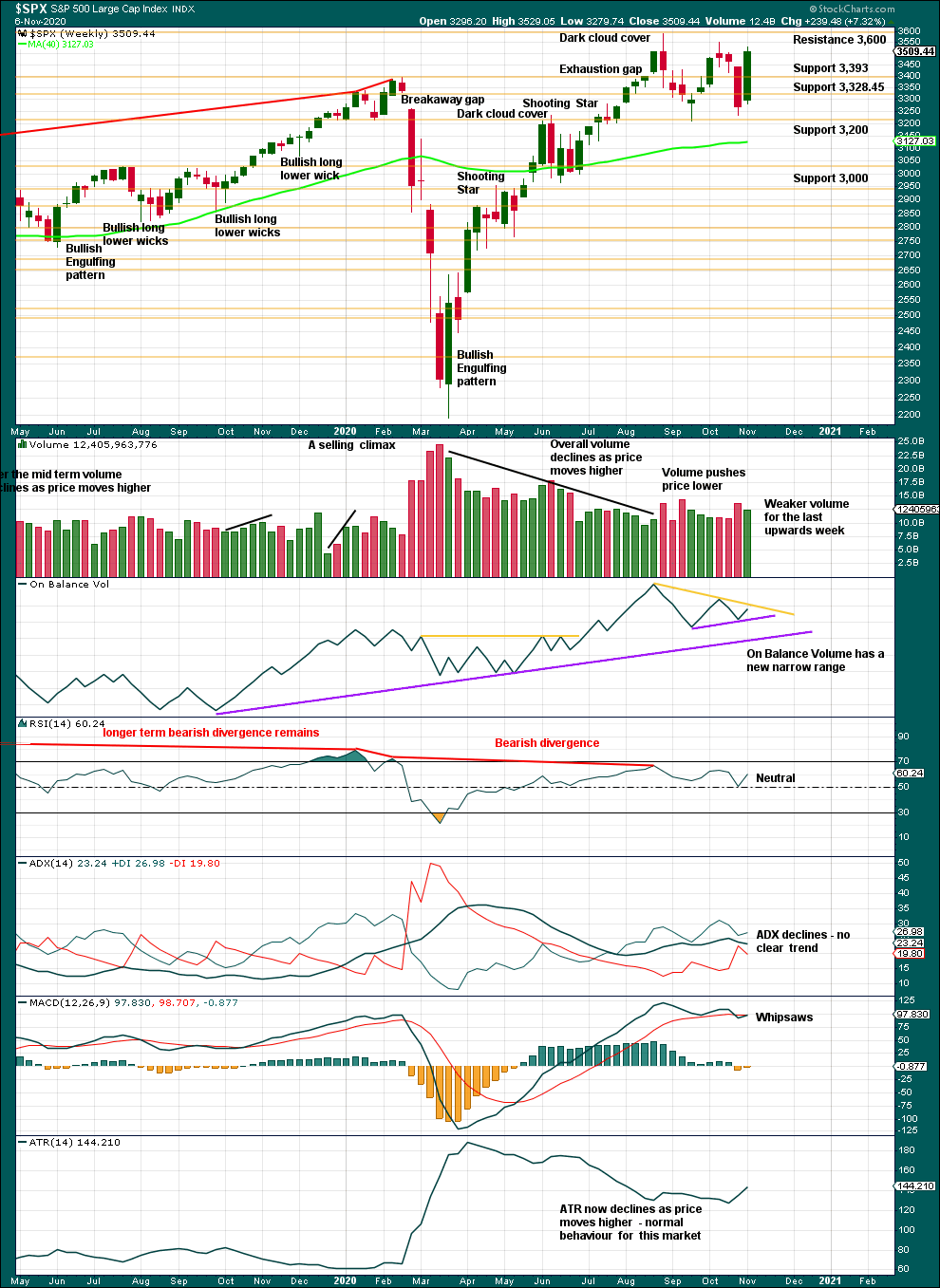
Click chart to enlarge. Chart courtesy of StockCharts.com.
A strong upwards week with strong range sees price remain within a consolidation zone. Resistance is about 3,590 to 3,600. Support is about 3,200. A breakout is required for confidence in the next direction.
DAILY CHART
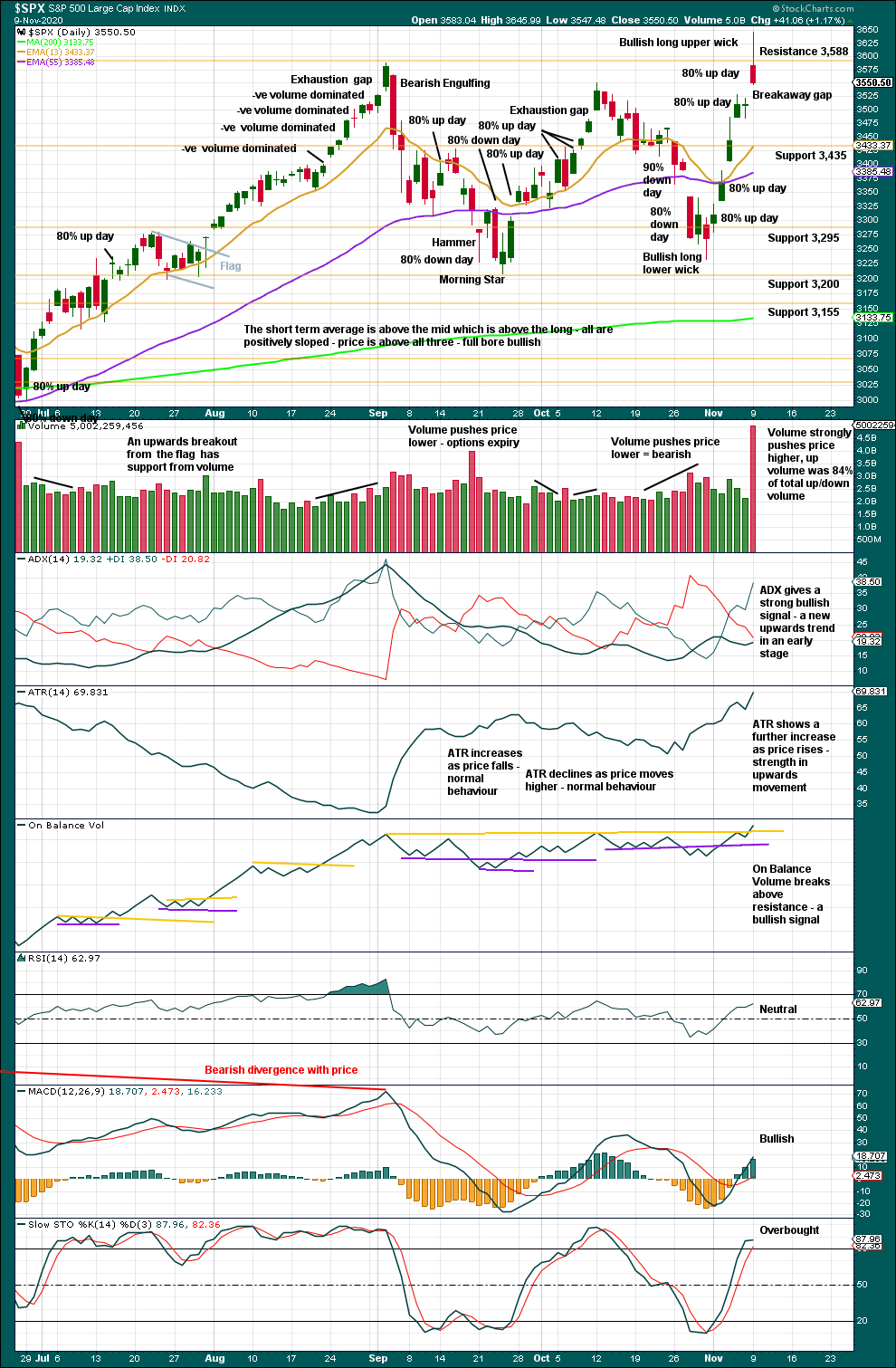
Click chart to enlarge. Chart courtesy of StockCharts.com.
This was a very strong upwards day, but the long upper wick is bearish. Assume the trend remains the same until proven otherwise. The trend is up.
Price did not close above prior resistance, but the gap up today remains open. While this gap remains open, it shall be considered a breakaway gap. Breakaway gaps are not usually closed (in the near future), so it may provide support at 3,529.05. If this gap is closed, then it should be renamed an exhaustion gap and a deeper pullback may then be expected.
BREADTH – AD LINE
WEEKLY CHART
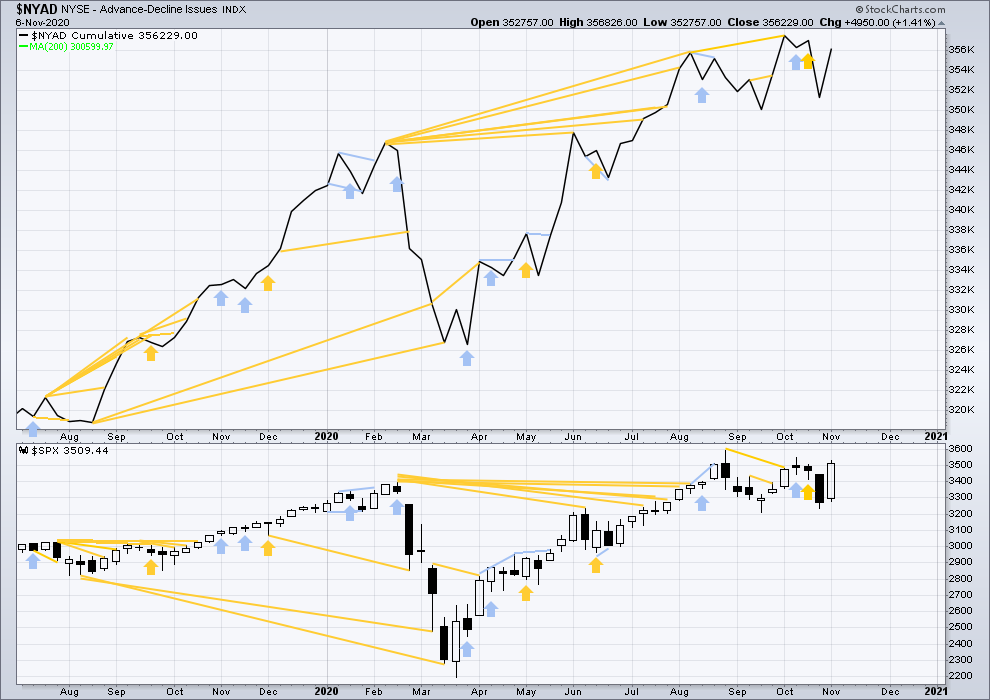
Click chart to enlarge. Chart courtesy of StockCharts.com. So that colour blind members are included, bearish signals will be noted with blue and bullish signals with yellow.
Breadth should be read as a leading indicator.
Lowry’s Operating Companies Only AD line has made a new all time high on the 12th of October. This erases prior bearish divergence with the last all time high in January 2020. With both the NYSE and OCO AD lines making new all time highs, breadth is leading price. This is a strong bullish signal and supports the main Elliott wave count.
Large caps all time high: 3,645.99 on November 9, 2020.
Mid caps all time high: 2,162.80 on November 9, 2020.
Small caps all time high: 1,100.58 on August 27, 2018.
Last week both price and the AD line have moved higher. Neither has made new short-term swing highs. There is no new divergence.
DAILY CHART
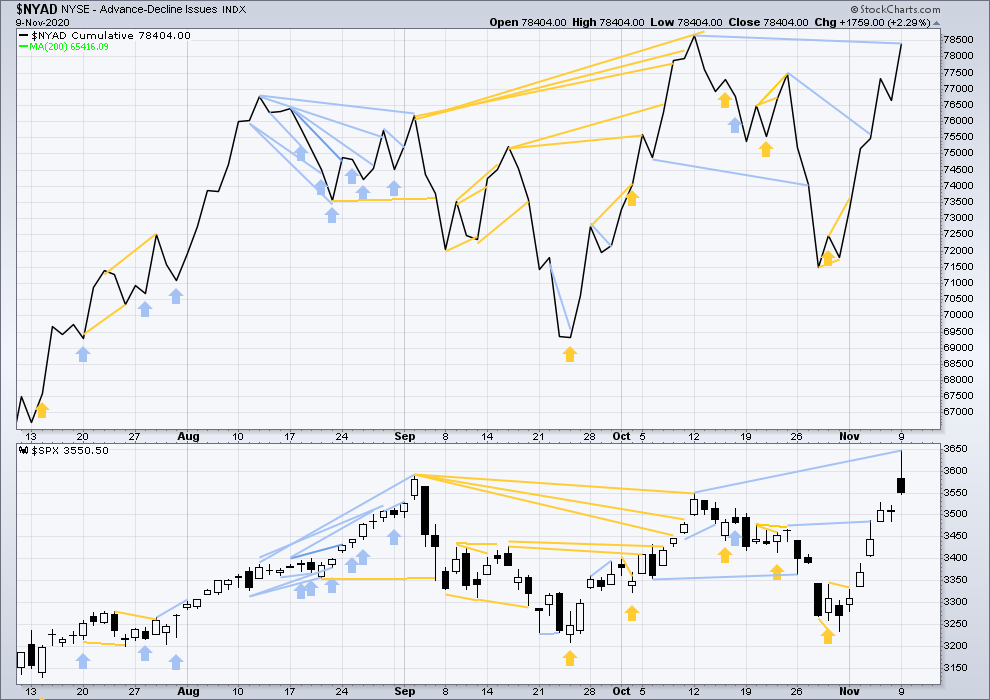
Click chart to enlarge. Chart courtesy of StockCharts.com. So that colour blind members are included, bearish signals will be noted with blue and bullish signals with yellow.
Today both price and the AD line have moved higher. Price has made a new all time high, but the AD line has not. This divergence is bearish, but it is not strong. This may offer a very small support to the alternate Elliott wave count.
VOLATILITY – INVERTED VIX CHART
WEEKLY CHART
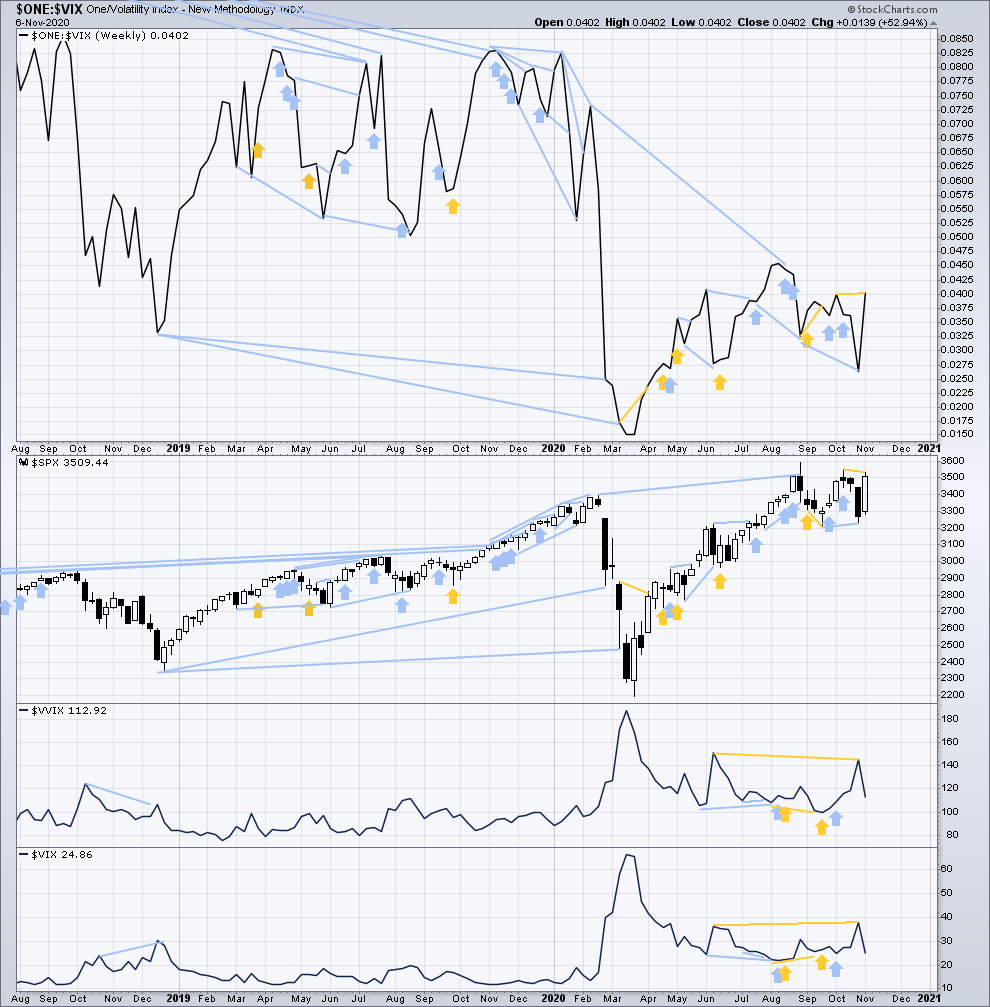
Click chart to enlarge. Chart courtesy of StockCharts.com. So that colour blind members are included, bearish signals will be noted with blue and bullish signals with yellow.
Inverted VIX remains well below all time highs. The all time high for inverted VIX was in the week beginning October 30, 2017. There is over 3 years of bearish divergence between price and inverted VIX. There is all of long, mid and short-term bearish divergence. This supports the second alternate Elliott wave count.
Last week price and inverted VIX have moved higher. Inverted VIX has made a very slight new high above the prior swing high, but price has not. This divergence is bullish for price, but it is very weak.
Comparing VIX and VVIX: Both VIX and VVIX have moved higher. VIX has made a new high above the prior high of the 8th of June, but VVIX has not. This divergence is bullish for price and may support either the main or first alternate Elliott wave counts.
DAILY CHART
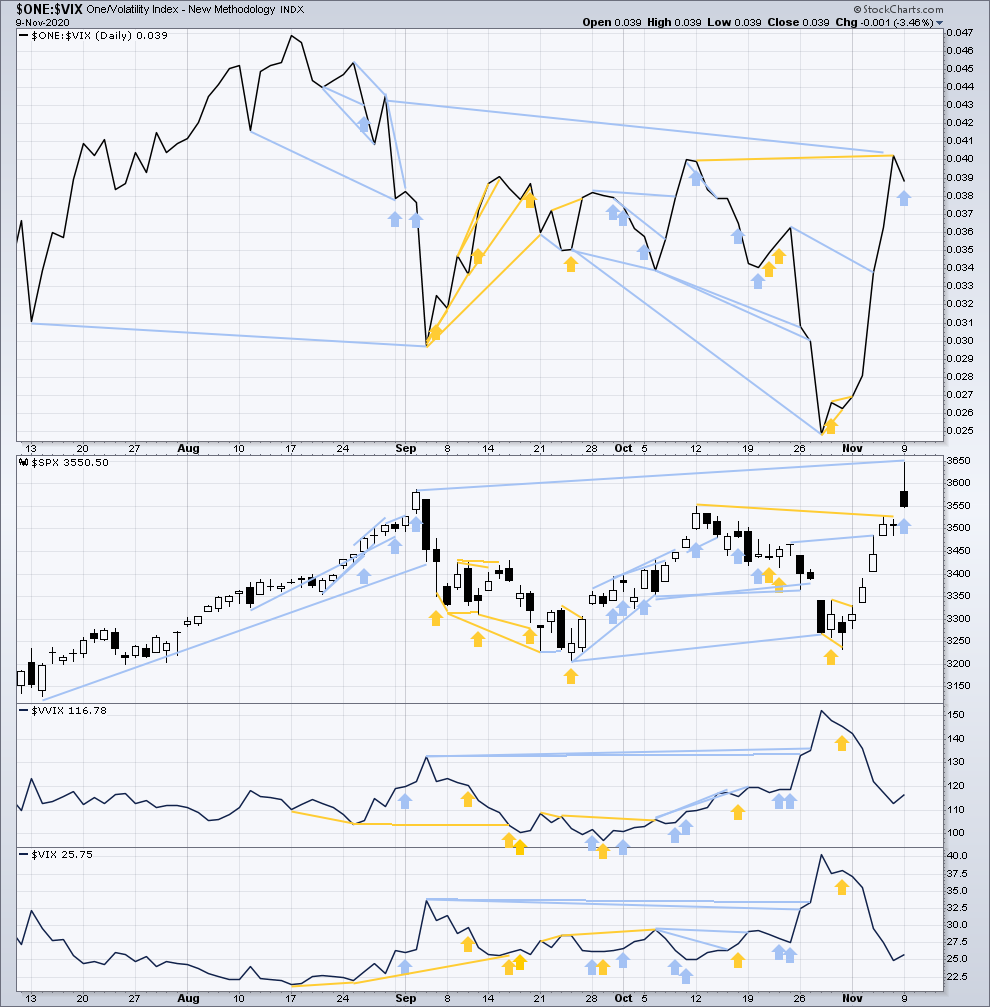
Click chart to enlarge. Chart courtesy of StockCharts.com. So that colour blind members are included, bearish signals will be noted with blue and bullish signals with yellow.
Bullish divergence noted in last analysis has now been followed by upwards movement, so it may be resolved.
Today price has moved higher, but inverted VIX has moved lower. Price has made a new all time high, but inverted VIX has not. There is now over 3 years of bearish divergence between price and inverted VIX. This supports the alternate Elliott wave count.
Comparing VIX and VVIX at the daily chart level: Today both VIX and VVIX have moved higher. There is no new divergence.
DOW THEORY
Dow Theory still concludes a bear market is in place.
Dow Theory confirmed a bear market with the following lows made on a closing basis:
DJIA: 21,712.53 – a close below this point was been made on the March 12, 2020.
DJT: 8,636.79 – a close below this point was been made on March 9, 2020.
Adding in the S&P and Nasdaq for an extended Dow Theory, a bear market was confirmed:
S&P500: 2,346.58 – a close below this point was made on March 20, 2020.
Nasdaq: 7,292.22 – a close below this point was made on the March 12, 2020.
At this time, to shift Dow Theory from viewing a bear market to confirmation of a new bull market would require new highs made on a closing basis:
DJIA: 29,568.57 – while DJIA made a new high above this point today, it has not closed above this point. Dow theory requires a close.
DJT: 11,623.58 – closed above on 7th October 2020.
Adding in the S&P and Nasdaq for an extended Dow Theory, confirmation of a bull market would require new highs made on a closing basis:
S&P500: 3,393.52 – closed above on 21st August 2020.
Nasdaq: 9,838.37 – closed above on June 8, 2020.
—
Always practice good risk management as the most important aspect of trading. Always trade with stops and invest only 1-5% of equity on any one trade. Failure to manage risk is the most common mistake new traders make.

